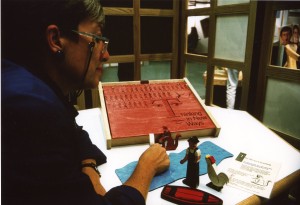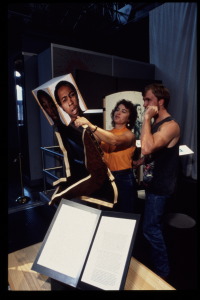I have been thinking for some time about museums’ propensity to imitate and reinforce the environments and methods of formal education. I think they need to refocus on what they do best: create informal environments for learning (very broadly defined) and enjoyment.
Importing a Classroom Mentality
I entered the museum field from the classroom over 30 years ago. From that time until I left institutional museum work in 2007 I have written or supervised the development of many teacher manuals to accompany exhibitions, conducted dozens of teacher workshops, and written countless justifications for how this or that exhibition or program met required educational standards. The longer I worked in museums the less I believed statements like: in engaging with Exhibition X, students will meet standards 1, 3, and 5.4 of the social studies curriculum, and standards 2 and 6.7 of the science curriculum. I had no doubt that students would derive educational value from a visit to the exhibition, but more and more I saw the experience as one of discovery, play, social interaction, and conversation, and less in terms of specific learning goals mandated by the local school system. Yet I continued to write formal education goals into grant proposals, letters informing schools of upcoming programs and exhibitions, and presentations to teachers and curriculum supervisors. I did this in order to gain funding and to attract school audiences; if anything I had to do this more and more over the years as outside funding became more necessary for our work and as school budgets for field trips were reduced.
I don’t regret any successes my colleagues and I had in attracting more funding and more school children. Evaluations required by the grants we were awarded showed that visitors were gaining rich and varied experiences from the exhibitions and programs we developed. Still I wish I had pushed back a bit more in my compliance with the demands of standards-based education. I regret that I did not find more ways to communicate the role of museums as unique and special environments for learning and enjoyment. Though they may have classrooms, museum teachers, and lesson plans, museums are not at their roots alternative schools. They are specially designed spaces that encourage engagement with three dimensional objects and/or activities; that move people through time and space; that involve graphic design, lighting, staging, and social interaction. In many ways they are more like theater than school, but more on that another time.
New Ways of Thinking About Museum Learning
Recently, several excellent resources on learning research have helped clarify and reshape my thinking on the formal/informal distinction in museum education.
In John Bransford et al,
How People Learn I found a compendium of scholarship on learning. I have known and admired Bransford’s work for years, since working with him on the development of components on cognition for the
Psychology Exhibition.

“Thinking in New Ways” Discovery Box based on Bransford’s research. Psychology Exhibition.
The studies discussed in Bransford confirmed for me that for the individual, learning is the same experience neurologically, psychologically, and cognitively, whether it happens in a formal or informal setting. In a classroom, in the back yard, in a kitchen, or in a museum, the process, as it happens in the brain, is the same. The neurons are firing, the synapses are connecting, and learning occurs. Bransford says that all learning is transfer; it is change – we gain new information, or expertise, or skills. The conditions that promote learning are also the same, whether in a formal or informal environment. We learn best when we can relate something new to what we already know. Learning is enhanced (or inhibited) by context, by prior knowledge, also by communication with others, by discussion and scaffolding. I have concluded that the line drawn between informal and formal learning is not especially useful; it is the environments (museum or beach) in which we learn, and the methods (testing, memorizing, tasting, touching, etc) we use, that are formal or informal, not the learning process itself. This may have been clear to many readers before, but something clicked for me when I understood this distinction.

An informal everyday setting for science learni
Museums as Intentionally Designed Spaces
A second publication, Philip Bell et al,
Learning Science in Informal Environments provided another “ah ha” moment. The report, published in 2009, summarizes and organizes current research on learning science in informal settings. Chapter 5, “Science Learning in Designed Settings,” contrasts everyday informal environments, such as the back yard or the kitchen, with environments such as museums that are “
intentionally designed for learning about science and the physical and natural world.” The report provides many examples of intentionally designed spaces for science learning – science museums and centers, aquariums, zoos, environmental centers and their designed components. I think the same claim can be made for art,
history, or other types of museums. All museums are intentionally designed spaces for learning about their particular facet of the human experience. Using an impressive array of current research, Bell and colleagues show that all kinds of learning (change) can happen in spaces designed for this purpose. In the case of science museums, visitor research shows that this can range from the acquisition of new science content to broader kinds of transformation – developing enthusiasm and excitement about science and the natural world; becoming familiar with scientific thinking and reasoning; a reinforced sense of identity; a sense of communion with nature.

An intentionally designed informal environment for science learning: The Rotating Faces encourage exploration of psychological research on facial expression of emotion. Psychology Exhibition.
I wish I had come to this concept of museums as intentionally designed spaces for learning much earlier in my career. It might have provided insights for persuading educators and policy makers that museums have a unique role in the range of experiences that can be called “educational.” The concept resonates with me because it
-
shifts the focus away from thinking that there are different learning processes, and promotes a more seamless understanding of human learning;
-
places the emphasis where it belongs in museums – on manipulating space – light, color, graphics, objects, specimens, language, activities – working with three dimensionality and considering how it affects visitor engagement, learning, and enjoyment.
This discussion has implications for much of the new thinking in museum work – from visitor-generated exhibitions, to online museums and exhibitions, to a re-discovery of the value of museum programs – all topics of other recent museum blogs. It also suggests that museum educators may have even more substantive roles to play in the design of museum experiences, especially as they continue to become knowledgeable about visitor research. And while writing those justifications for how Exhibition X will address (not necessarily meet) STEM (Science, Technology, Engineering, Math) and STEAM (add Art) standards, how about building a new vocabulary (one I never had) that provides some nuance; that illustrates how museum environments and methods are powerful and full of impact in and of themselves.


